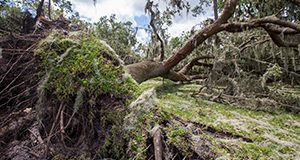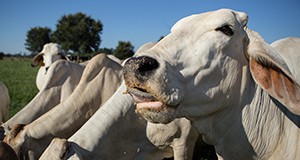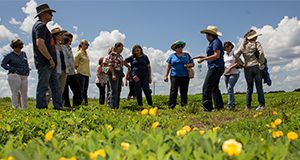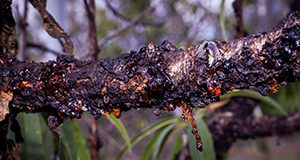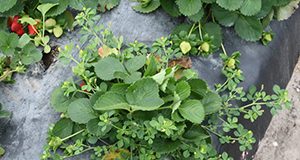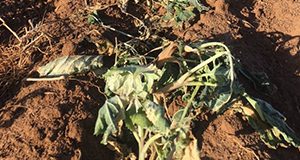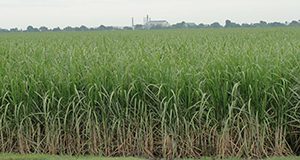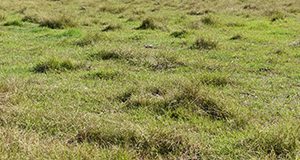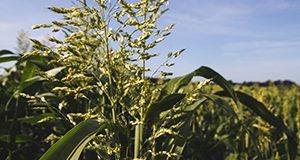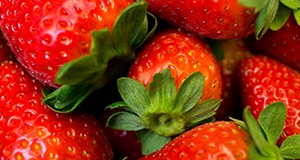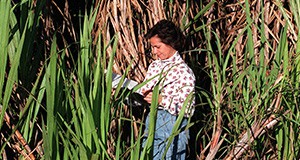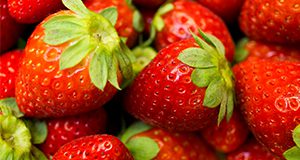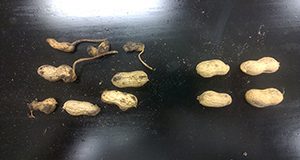Hurricanes are capable of affecting almost everything in their paths. Their strong winds and heavy rains can directly impact both inland and coastal areas in short periods that usually last about a day. This new 10-page document reviews basic facts about hurricanes and their effects in Florida and discusses ways they might affect Florida's agriculture and natural resources. Written by Young Gu Her, Ashley Smyth, Pamela Fletcher, Elias Bassil, Ulrich Stingl, Zachary Brym, and Jiangxiao Qiu, and published by the UF/IFAS Department of Agricultural and Biological Engineering, October 2018.
http://edis.ifas.ufl.edu/ae528
Category: Crops
Labor Shortages in the Florida Strawberry Industry
Florida is the largest supplier of domestic winter strawberries in the United States, and labor is the largest cost item in the Florida strawberry production budget. Labor shortages are a major threat to the industry. This 3-page fact sheet written by Trina Biswas, Feng Wu, and Zhengfei Guan and published by the UF/IFAS Food and Resource Economics Department investigates growers’ labor demand and labor shortages based on a survey conducted in 2016.
https://edis.ifas.ufl.edu/fe1041
Mycotoxins in Florida Pastures
Beef cattle producers in Florida have expressed concerns about the potential presence of mycotoxins in summer perennial forages. In other regions of the US, mycotoxins in forage crops have caused productivity and economic losses. This 3-page fact sheet provides information about the current state of knowledge regarding mycotoxins in Florida perennial grass pastures. Written by Marcelo Wallau, Brittany Justesen, Ann Blount, Luiz Ferraretto, Glen Aiken, and Aaron Stam, and published by the UF/IFAS Agronomy Department, August 2018.
http://edis.ifas.ufl.edu/ag422
Strip-Planting Rhizoma Peanut into Grazing Systems
Nitrogen (N) is one of the major off-farm inputs in livestock systems, either in the form of N fertilizer or purchased feed. Fortunately, you can reduce those expenses by growing your own nitrogen using forage legumes. Rhizoma perennial peanut (RPP) is a legume adapted to the Florida environment that grows well in mixtures with bahiagrass. This 4-page fact sheet discusses varieties, establishment, weed management, grazing management, and the cost-share program. Written by Jose Dubeux, Lynn Sollenberger, Joao Vendramini, Marcelo Wallau, Ann Blount, Liza Garcia-Jimenez, Erick Santos, and David Jaramillo, and published by the UF/IFAS Agronomy Department, July 2018.
http://edis.ifas.ufl.edu/ag421
Peach Rust (Transchelia spp.)
Peach rust is a fungal disease that attacks plants like peach, nectarine, almond, plum, apricot, and cherry. Infections can be particularly severe in warm weather with high rainfall, so Florida summers provide favorable conditions for peach rust development. This 6-page document describes the characteristics and management of peach rust. Written by Daniel Mancero-Castillo, Ali Sarkhosh, Courtney Ligon, Mercy Olmstead, and Philip Harmon and published by the UF/IFAS Horticultural Sciences Department, July 2018.
https://edis.ifas.ufl.edu/hs1263
Fungal Gummosis in Peach
Peach fungal gummosis (PFG) is a vascular disease that limits the growth and yield of peach orchards in the southeastern United States. This 6-page document discusses the symptoms and management of PFG. Written by Daniel Mancero-Castillo, Ali Sarkhosh, Sara Sherman, Mercy Olmstead, Philip Harmon, and Thomas Beckham and published by the UF/IFAS Horticultural Sciences Department, July 2018.
https://edis.ifas.ufl.edu/hs1265
Control of Black Medic in Strawberry Production
Black medic is an annual broadleaf weed that competes with strawberry crops and impedes harvest. This 4-page document describes how to manage black medic in strawberry production. Written by Shaun M. Sharpe and Nathan S. Boyd and published by the UF/IFAS Horticultural Sciences Department, July 2018.
https://edis.ifas.ufl.edu/hs1319
Seed Piece Spacing Adjustment for Florida Chipping Potato
Seed spacing directly affects crop revenue because the number of potato seeds planted determines the final plant population density. The analysis presented in this 5-page publication was extracted from a series of field trials that looked at improved potato plant arrangement in the field by adjusting seed piece spacing for Florida growing conditions. Written by Fernanda Souza Krupek, Steven A. Sargent, Peter J. Dittmar, and Lincoln Zotarelli and published by the UF/IFAS Horticultural Sciences Department, May 2018.
http://edis.ifas.ufl.edu/hs1317
Biology and Management of Dodder (Cuscuta spp.) in Ornamental Crop Production and Landscape
Dodder are a group of over 150 species in the genus Cuscuta. This 4-page publication was developed to help commercial growers, landscape professionals, and homeowners identify and manage dodder infestations in their greenhouses, nurseries, or landscapes. Written by Kaley Mierek, Chris Marble, Nathan Boyd, and Shawn Steed and published by the UF/IFAS Environmental Horticulture Department, May 2018.
http://edis.ifas.ufl.edu/ep556
Frost Damage of Carinata Grown in the Southeastern US
Brassica carinata is an annual oilseed crop used for the commercial production of jet fuel. One of the challenges to commercialization of this crop in the southeastern United States has been frost damage. This 4-page fact sheet discusses symptomology and ways to minimize risk of frost damage to carinata. Written by Michael J. Mulvaney, Ramdeo Seepaul, Ian Small, David Wright, Silvana Paula-Moraes, Carl Crozier, Paul Cockson, Brian Whipker, and Ramon Leon, and published by the UF/IFAS Agronomy Department, May 2018.
http://edis.ifas.ufl.edu/ag420
Florida Crop/Pest Profile: Sugarcane
Sugarcane (Saccharum interspecific hybrids) is the main source of sugar in the world. It is grown in more than 90 countries in tropical and subtropical regions. Cultivation techniques and production challenges vary by location (Rott 2017; Rott 2018). This 19-page document discusses characteristics of the sugarcane crop and pests affecting its production in Florida, which is the largest producer of sugarcane in the United States. Written by P. Rott, D. C. Odero, J. M. Beuzelin, R. N. Raid, M. VanWeelden, S. Swanson, and M. Mossler, and published by the UF/IFAS Agronomy Department, revised May 2018.
http://edis.ifas.ufl.edu/pi207
Brunswickgrass or Paspalum nicorae: A Weed Contaminant in Southern Pastures and Bahiagrass Seed Production Fields
Brunswickgrass (Paspalum nicorae Parodi) is becoming a problematic weed in summer perennial grass pastures in the Southeast. The plant is competitive with bahiagrass
and bermudagrass. Since it is less palatable, it can eventually dominate a perennial grass pasture. Brunswickgrass has become naturalized and has reportedly contaminated bahiagrass seed fields and pastures in the southeastern states, including some of the important counties for seed production in Florida, such as Gilchrist, Levy, Alachua, Citrus, and Sumter. This 4-page fact sheet provides an overview of brunswickgrass and discusses its appearance, variety/germplasm, and management. Written by Ann Blount, Marcelo Wallau, Brent Sellers, Dennis Hancock, Leanne Dillard, Jose Dubeux, Cheryl Mackowiak, Joao Vendramini, and Clay Cooper, and published by the UF/IFAS Agronomy Department, April 2018.
http://edis.ifas.ufl.edu/ag408
Degree-Days: Growing, Heating, and Cooling
How much and when it rains, freezes, and thaws can make the difference between boom and bust for a year's crop. However, temperature can predict more than boom or bust. Atmospheric temperature can predict the growth rates of many plants. For this reason, growers use a concept called growing degree-days (GDD), sometimes called heat units. This 5-page document discusses growing degree-days, use of the AgroClimate website to track and forecast GDD accumulation, heating and cooling degree-days, and methods for calculating HDD, CDD, and GDD. Written by Clyde W. Fraisse and Silvana V. Paula-Moraes, and published by the UF/IFAS Department of Agricultural and Biological Engineering, revised December 2010 and April 2018.
http://edis.ifas.ufl.edu/ae428
AgroClimate Crop Season Planning Tool: Reducing the Risk of Extreme Weather Events During Key Stages of Crop Development
This 5-page publication details a new tool available to growers and Extension professionals to manage risks related to climate during seasonal planning stages. The Crop Season Planning tool is a climate-based tool that enables growers to plan planting strategies that will minimize risk to climate extremes based on historical climate data at their location. Written by Caroline G. Staub, Daniel Perondi, Diego Noleto Luz Pequeno, Patrick Troy, Michael J. Mulvaney, Calvin Perry, Brian Hayes, Willingthon Pavan, and Clyde W. Fraisse, and published by the UF/IFAS Department of Agricultural and Biological Engineering, March 2018.
http://edis.ifas.ufl.edu/ae525
Florida Strawberry Growers Need More Early Yield to Improve Profitability
Fresh strawberries are a major US fruit crop. This 3-page fact sheet written by Feng Wu, Zhengfei Guan, and Vance Whitaker and published by the UF/IFAS Food and Resource Economics Department summarizes recent research on strawberry yield patterns and how they are predicted to affect profits. It is intended primarily for those involved in Extension, marketing, policy-making, production, and research related to the Florida strawberry industry. We believe that a better understanding of yield and price dynamics will be valuable to industry decision-makers.
http://edis.ifas.ufl.edu/fe1032
Sugarcane Cultivar Descriptive Fact Sheet: CPCL 02-6848 and CPCL 05-1201
CPCL 02-6848 and CPCL 05-1201 are emerging sugarcane cultivars in Florida. Both cultivars were released commercially in 2012 and were quickly adopted by local sugarcane growers because of high yields and moderate to high resistance against major sugarcane diseases in Florida. This 4-page fact sheet provides basic information and yield and disease information to assist growers in management of these cultivars. Written by Hardev Sandhu and Wayne Davidson, and published by the UF/IFAS Agronomy Department, March 2018.
http://edis.ifas.ufl.edu/sc104
Cost Estimates of Producing Sapodilla in South Florida, 2017
This 6-page fact sheet written by Edward A. Evans, Fredy H. Ballen, Aditya Singh, and Jonathan H. Crane and published by the UF/IFAS Food and Resource Economics Department provides an estimate of the costs and returns associated with an established sapodilla orchard in south Florida. The information presented is based on a wide range of production practices collected through field interviews with growers and industry specialists and is intended as a guide to estimate the financial aspects of operating an established sapodilla grove. Please note that sapodilla has been assessed by the UF/IFAS Invasive Plants Working Group as potentially invasive in south and central Florida. It should not be planted in home landscapes or in groves near natural areas. Sapodilla plantings must be fenced, and the fruit must be moved in covered vehicles to prevent fruit being eaten by wildlife and the plant from infesting areas outside the grove.
http://edis.ifas.ufl.edu/fe1015
CRISPR Gene Editing in Strawberry
Because cultivated strawberries are genetically complex, conventional breeding of strawberry can be difficult. Therefore, gene editing can be useful when developing strawberry varieties. This 3-page document discusses CRISPR gene editing in strawberry. Written by Seonghee Lee, Cheolmin Yoo, Kevin Folta, and Vance M. Whitaker and published by the UF/IFAS Horticultural Sciences Department, February 2018.
http://edis.ifas.ufl.edu/hs1315
Management of Plant-Parasitic Nematodes in Florida Peanut Production
Nematodes, non-segmented roundworms, can cause serious yield suppression in peanut production. This 10-page fact sheet written by Zane J. Grabau and Donald W. Dickson and published by the UF/IFAS Department of Entomology and Nematology explains how to recognize a potential nematode problem in a peanut production, confirm it with an expert, and choose the best management tools to control the problem.
http://edis.ifas.ufl.edu/in1199
Growing Pomegranates in Florida: Establishment Costs and Production Practices

The study described in this 6-page fact sheet written by Feng Wu, Zhengfei Guan, and Gary Vallad and published by the UF/IFAS Food and Resource Economics Department provides a description of pomegranate production practices and preliminary cost estimates to inform investment and production decisions when growers look to diversify and grow pomegranate as a niche crop.
http://edis.ifas.ufl.edu/fe1024
